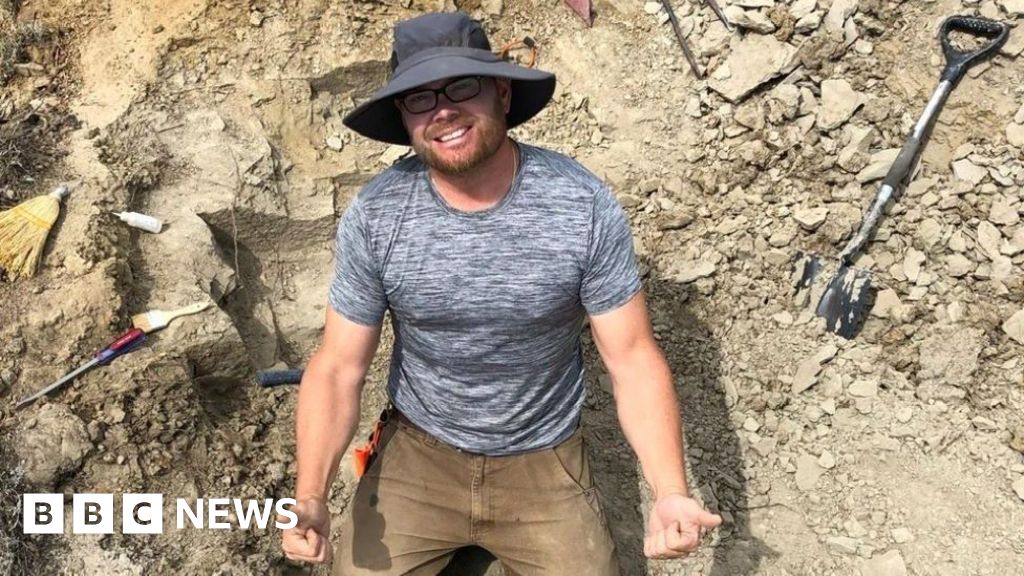
Dinosaur hunter stumbles across million-dollar find
- Science
- May 31, 2024
- No Comment
- 281
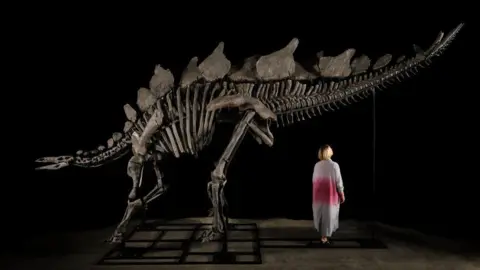 Matthew Sherman
Matthew ShermanThe first stegosaurus skeleton to go under the hammer is set to fetch millions of dollars in New York. But the extraordinary discovery was made by chance, thousands of miles away out west during one man’s birthday stroll, writes Stephen Smith.
It’s every child’s dream to wander into the garden and come face to face with a real-life dinosaur, ideally one of the less terrifying ones which follow a sensible plant-based diet.
For most of us, a dream is all it is, but not for a man called Jason Cooper.
He has encountered dinosaurs in his backyard not once but on many different occasions.
In fact, when he goes for a stroll around his property in the American Southwest, he’s more likely than not to run into a creature from prehistoric times.
But even so, he may never come across a specimen quite like the one he stumbled upon a couple of years ago, an animal so massive that if it appeared on a London street, it would measure up to an old, double-decker Routemaster bus – though you’d want to be careful about which one you boarded.
It was an enormous stegosaurus, in excellent condition for a beast that’s spent the past 150 million years below ground.
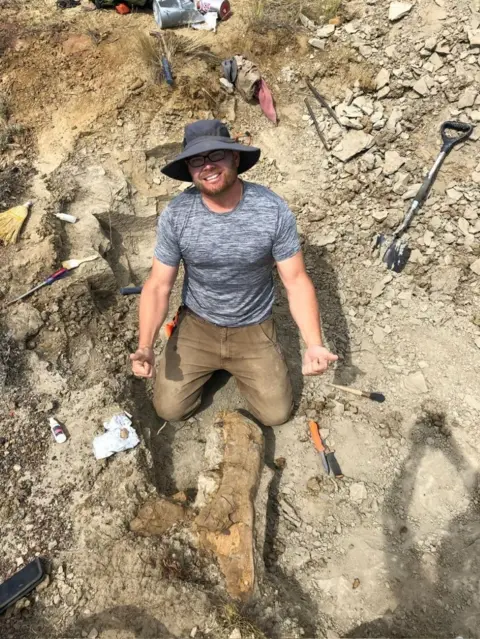 Jason Cooper
Jason CooperIt’s almost 11.5ft tall (3.5m) and fully 27ft from the top of its head to the tip of its scaly tail.
Mr Cooper has dubbed it “Apex”, because its formidable dimensions would have made it a dominant animal in its environment.
With the help of some friends, he’s cleaned it up and put it back together again.
And if you’ve always had the fantasy of bumping into a dinosaur on your lawn, you can make it come true – if you can lay your hands on $4m-$6m.
Apex is about to become the first stegosaurus to go under the hammer at auction.
Bidding is expected to be brisk. Dinosaur fossils have become desirable trophies, coveted by successful tech entrepreneurs and Hollywood stars.
This has caused much dismay among academic palaeontologists, who claim that allowing them to end up in private hands hinders scientific research and denies the public the chance of appreciating them.
Nicolas Cage reportedly purchased a tyrannosaurus skull for more than £185,000 in 2007 after a bidding war with Leonardo DiCaprio, though he returned it after it emerged that it had been stolen.
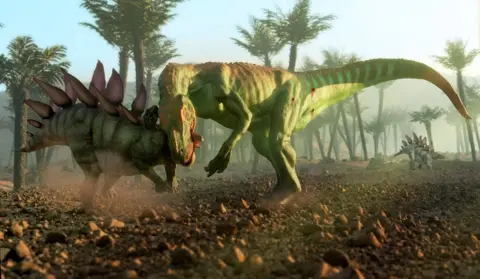 Mark Garlick/Science Photo Library
Mark Garlick/Science Photo LibraryMr Cooper is a professional fossil hunter, having turned the childhood dream of discovering dinosaurs into reality, with the pragmatism of a theatre buff deciding to rent close to Broadway.
He and his family live in Colorado on top of a geological feature known as the Morrison Formation, a stretch of sedimentary rock dating back to the Jurassic period which covers 600,000 square miles of the western United States.
The Morrison Formation is to dinosaurs what California was to nuggets of gold in the mid-19th Century.
And to the romantically minded, Mr Cooper and others like him are prospectors on the last American frontier, the unknown land beneath their own muddy boots.
He owns just under 100 acres and in the past dozen years he’s pulled 10 dinos out of them. And to hear him tell it, bagging his greatest find to date was literally a walk in the park.
It was his 45th birthday and when his friend asked him what he wanted, he declared the best gift would be a new dinosaur and so they set out. And as they walked up the side of a mountain, Mr Cooper spotted a femur bone sticking out of the rock wall.
“We looked around. My friend found some vertebrae. I said, ‘Oh my gosh, this is turning out to be a really great birthday!'”
The cliff-face of clay, mud and sand where Cooper spotted Apex is like a cross-section of all the deposits which have settled in that part of the world through time.
“I saw the spikes of a tail sticking out and a couple of the big plates on its back. I could tell it was still curled up.”
After the fossil hunters had recorded as much data as they could about where Apex was found, its bones were taped up in protective “jackets” made of plaster and burlap and lifted onto a trailer.
 Getty Images
Getty ImagesBack at Cooper’s dino-shop, work began to clean and reassemble the stegosaurus, with equipment including sand-blasting jets, pneumatic chisels and powerful microscopes.
Fossilisation meant that the bones had been encased in rock; this was painstakingly removed, to lay bare the animal’s skeleton.
“Apex is 70% complete which is incredible for a dinosaur, especially a stegosaurus,” said Cooper.
To put that in context, ideas of “completeness” in the fossil world are almost as prickly as a stegosaurus’s tail, according to Cassandra Hatton of Sotheby’s, which is overseeing the sale.
“Nobody ever found 100% of a dinosaur. ” A stegosaurus as good as this is hard to find, she says. “I think it’s going to be incredibly important.”
Apex didn’t appear to have been damaged in fights with other creatures. The only indication of wear and tear was that its lower vertebrae had fused with the pelvis, an effect of arthritis, suggesting the stegosaurus enjoyed a long life before an eternity in the ground.
Now it will be carefully disassembled again, prior to the long and steady haul overland from Cooper’s spread to the dealing rooms of Sotheby’s in Manhattan, where Apex will be put back together and go on show to the public and prospective buyers in July.
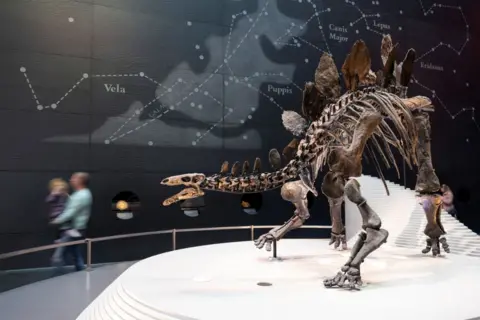 Getty Images
Getty ImagesIt’s 200 years since natural historians began to classify dinosaurs, and their successors rue the sale of Apex on this anniversary.
Steve Brusatte, professor of palaeontology and evolution at the University of Edinburgh, who is originally from the US, says stegosaurus specimens are very rare and, if genuine, this one belongs in a museum.
“It is a great shame when a fossil like this, which could educate and rouse the curiosity of so many people, just disappears into the mansion of an oligarch.”
In the UK, fossil enthusiasts are generally allowed to hold onto smaller, common varieties, such as shells and corals, but must report any significant finds.
No such restrictions in the US, where anyone digging up a dinosaur on their own property is entitled to do with it as they please and that includes making a handsome living out of it.
Read more from this author
Jason Cooper defends selling the stegosaurus he found, arguing that he and his critics are essentially on the same page.
“The collectors and philanthropists who purchase these dinosaurs might enjoy them at home for a few years, but then they have the fossils named after them and give them to institutions,” he tells the BBC. Cooper says he has donated to public collections himself.
When the hammer comes down on the sale, Cooper will be back in dinosaur country, looking for more fossils, some of which he will give away to public collections. Of course, they’re not exactly scarce where he comes from. He compares finding dinosaurs to another childhood dream that sounds almost as improbable. “It’s like looking for gold coins, except you know where the king’s counting house used to be.”
Stephen Smith is a writer and broadcaster
#Dinosaur #hunter #stumbles #milliondollar #find










